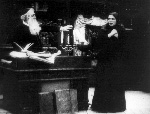Gyöngyi Balogh:
IN THE WAKE OF HUNGARIAN FILMS

One day is the world
32 Kbyte
Is it lost? Destroyed? Collecting dust on an attic? Who knows?
The same destiny was given to 95% of the Hungarian silent movies and 25 % of the sound pictures made before 1945. Silent feature films of Michael Curtis shot in Hungary have simply vanished. Fortunately, Az aranyember /The Golden Man/ by Sir Alexander Korda, shot in 1918 can be seen still, but the other 23 films made in Hungary by him are only known through photographs and descriptions published in contemporary newspapers. None of the silent films of Pál Fejõs or Géza Bolváry survived. The careers of future stars like Vilma Bánky, Pál Lukács, Mihály Várkonyi, Franciska Gaál, Béla Lugosi have all started in Budapest, but the memory of this fact is only preserved by a few hundred meters of fragmented sequences. One of the first international hit of the Hungarian sound picture era, Pardon, tévedtem /Pardon, I was wrong/ (1933) is missing, films like Beszállásolás /Billeting/ (1938), Álomsárkány /Dream Dragon/ (1939), Mátyás rendet csinál /Mátyás puts it right/ (1939), Megálmodtalak /I dreamt you/ (1943), Muki (1943) and many others of film historical importance are lost.
In Hungary, the notion of film preservation has been accepted only too late, in the fifties. The Hungarian Film Institute has been established in 1957, and as the guardian of the national film collection it keeps on looking for and trying to acquire the missing Hungarian films for the collection continuously. This work has not been finished yet and over the last ten years more than 30 films previously considered to be lost completed the stock of the archives. 5 silent films among them! Most of the films were exchanged from European film archives, but in the past few years due to the appeals published in Hungarian speaking newspapers abroad more and more from among emigrant Hungarians begin to feel that the best place for the films preserved by them for decades is the Hungarian national collection. Films like Mámi, Makkhetes /Club Seven/, A királyné huszárja /The Hussar of the Queen/, 2Havi 200 /200 fix / month/, Piri mindent tud /Piri knows everything/, Nevetõ Budapest /Laughing Budapest/, Toroczkói menyasszony /The bride of Toroczkó/ have arrived from America, the collection of Miklós Kossányi, from Béla Bunyik the Hungarian Film Archives received Falusi lakodalom (Ellopott szerda) Country wedding (The stolen Wednesday), A leányvári boszorkány /The Witch of Leányvár/, Szerelmi álmok /Love Dreams/, Nincsenek véletlenek /There is no accident/, Az ember néha téved /You are wrong sometimes/, Varjú a toronyórán /Crow on the church clock/, Csókolj meg édes /Kiss me, dear/. From László Fabó have arrived Igen, vagy nem? /Yes or no?/, Az elkésett levél /The belated letter/. István Kotsis brought back the films Szerelembõl nõsültem /I married for Love/, Repülõ arany /Flying Gold/, and Tilos a szerelem /No love/ from Canada.
Restoration of the films discovered
Most of films returning home survived on inflammable and explosive nitro raw material. These films have to be copied to secure raw material before the degrading process threatening nitro films would start. After the repair and cleaning of the physical injuries of the celluloid the security copies can be made. Weakening of the scratches can be obtained by copying in fluid. When copying a frequent problem can be shrinkage which threatens the sound track first of all. Solving of this problem is served by a local patent, a special equipment to fix the soundtrack, but sometimes event this is no help. In the case of Jómadár /Bad egg/ and Sárga kaszinó /Yellow Casino/ for example the sound of the film could only be saved by using a complicated and very costly computer method.The rolls sometimes get into the hands of the experts only belatedly. A Hungarian silent picture made in 1916, Simon Judit was brought back from Moscow and in two of the scenes the degradation threatening nitro films has started. These damages unfortunately cannot be helped by the technical tools available today. In the first act of Nincsenek véletlenek /There is no accident/ which got back from America, the decay also began damaging images and sound alike, but using the computerised sound restoration method experimented in the last few years it might possibly be brought into a projectable state.
The renewal of a nitro film of average length in good state costs 800 000 forints based on current prices of raw material and laboratory. When a film arrives with its emulsion damaged and because of this it requires special procedures for restoring images or sound, or some parts have to be blown up from a 16 mm copy, this amount can achieve as much as 1,5-2 million forints. The Hungarian Film Institute has a nitro film restoration budget of 5 million forints a year, which is only sufficient for the restoration of a few films and, due to the raising prices this number is less and less from year to year.
Dead-and-alives of the Hungarian film
Films truncated unprojectably lie fallow seemingly dead on the shelves waiting for the magic, the good luck that maybe another fragment arrives, truncated some other place, the two fragments united might have a chance to resurrect, roll again between the sprockets of the projector and the long forgotten story preserved on their frames can appear on the white screen.The greatest celebration of the restorer is such a rebirth, where he/she can be of assistance. Thus Kétszer kettõ /Two times two/ became visible again from a 35 mm and a 16 mm fragments last year. Egér a palotában /Mouse in the palace/ and Makacsa Kata /Taming of the Shrew/ are in the process of renewal from two 35 mm fragments right now. Last year the films Bob herceg /Prince Bob/, Elkésett levél /The belated letter, Torockói menyasszony /The Bride of Torockó/, Tilos a szerelem /No love and János vitéz /John, the Valiant Knight had the rare luck to be complemented in their deficient copies by 16 mm copies received from Canada and the US. Provided there would be enough resources to finance the costly process of blow up, wholesome, projectable copies could also be completed. It is similarly a matter of finances whether Tiszavirág /Day-fly/ can be reborn again. A wonderful but silent copy of this survived in the institute and recently a sound 16 mm copy of the film emerged from a collector in Hungary which is unfortunately not complete. However, as the dialogue list of the film is still existing, deficiencies in sound can be supplemented by post-synchronisation. In the case of Hetenként egyszer láthatom /I can see her once a week/ a similar work has been done. In the sound track of this film one act is missing and therefore the silent act was dubbed subsequently. The film is being presented ever since and most of the audience do not notice the intervention at all. The task was aggravated by the fact that the dialogue list of the film did not survive and therefore the text could only be restored from the moving of the lips.
And when there is no help any more...
Certainly most of the film fragments are waiting for renewal in vain: films like Bor /Vine/, Annamária, Bors István, Haláltánc /Dance Macabre/, Mindent a nõért /Everything for the woman, Õrségváltás /Change-over/, A varieté csillagai /The stars of variety show/ and many others presumably will never be presented to the audience again. They might only be projected in their remnants from time to time for film historians.Many films lie somewhere scattered around on a too hot attic or a too damp cellar and begin to degrade maybe just in these days without anybody knowing and helping. Recently two such cases were revealed, unfortunately too late. In the hot summer of 1994 in a collection in Hungary three old Hungarian film caught fire and smoked away almost causing the death of the owner. In February 1995 the copy of Idegen utakon /Strange roads/ stored in a moist cellar emerged with damaged emulsion. One quarter of the celluloid suffered unrecoverable damages and it cannot be presented any more.
May deterioration be the sad fate of less and less films in the future.
The Hungarian Film Institute (1021 Budapest, 51/b Budakeszi út) appeals to everyone possessing old timer moving pictures or know about them to be of help in getting these into the hands of experts as soon as possible. Besides we request those who can afford to support the restoration works of old films to transfer their donations on the following account: Foundation for the Past and Future of the Hungarian Film, Hungarian Foreign Trade Bank 203-35524-7007.

200 fix/month
50 Kbyte

Simon Judit
28 Kbyte

Two times two
32 Kbyte

Mouse in the palace
39 Kbyte

Taming of the Shrew
30 Kbyte

Dance Macabre
27 Kbyte

